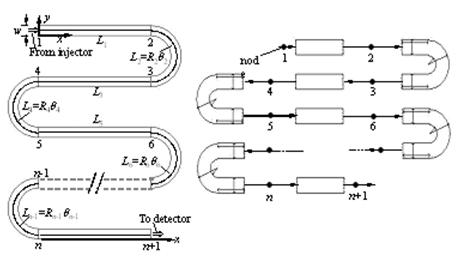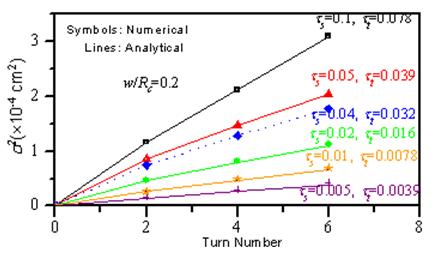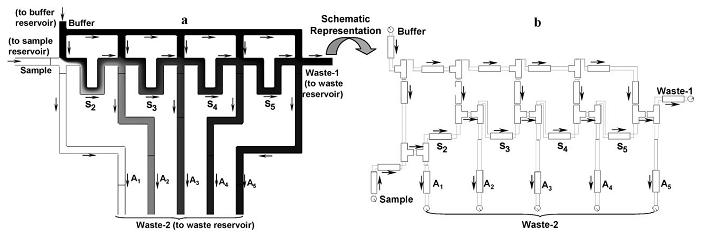| People | Research |
|
System-level models for electrokinetic microfluidic separations and mixing
In early stages of this project, we focused on developing efficient and accurate physical
models for electrokinetically based separation microchannels and using them to perform system-level simulations and
synthesis for generation of optimal designs that demonstrates 100 ~ 100,000x speedup over full numerical computations
and trial-and-error experiments. These models can be used to critically enable CAD tools using a bottom-up iterative
design methodology for multi-functional and integrated lab-on-a-chip (LOC) systems. The graphic below shows a schematic of a serpentine-shaped electrophoretic separation
microchannel. An analyte band migrating under electrophoresis will experience dispersion (or analyte band broadening)
due to diffusion and non-uniformities in migration velocity, which can be caused by such factors as channel curvature
and Joule heating. We have developed an efficient and accurate system-level model for describing dispersion in such
complex-shaped microchannels. The model consists of component-level physical models (e.g., for describing curvature
and Joule heating-induced dispersion) for individual channel elements of simple shapes (e.g., straight channels and
semi-circular turns), which are assembled in such a way that neighboring elements are linked at their interface by a
minimal set of physical parameters (e.g., the electric potential, separation time, analyte band variance, and
coefficients representing the shape of a skewed analyte band). We have validated the system-level model with both
experiments and full numerical simulations, with worst-case discrepancies ranging from < 1% to 9.5% depending on the
dominance of convection in the dispersion process. A speedup of up to 15,000 has been observed for our model over
full numerical simulations.  A serpentine-shaped electrophoresis micro-channel and its representation as a system. The entire channel is decomposed into a system of microfluidic elements with simple geometries. Analytical models for such elements are developed and then linked through proper parameters at the element interfaces to form a system-level lumped-parameter model.  Analyte band variance computed from system-level and full numerical simulations for a six turn serpentine channel. For each turn, the results from the system-level analytical simulation agree with those from numerical simulation within 10%. Additionally, we have developed a model for the efficient and accurate simulations of laminar
diffusion-based complex-shaped electrokinetic passive micromixers, which are represented as a system of mixing elements
of relatively simple geometry. Parameterized and analytical models for the mixing elements were derived, which hold for
general sample concentration profiles and arbitrary flow ratios at the inlets of the mixing element. A lumped-parameter
and system-level model was then constructed for a complex micromixer, in which the constituent mixing elements are
represented by element models, in such a way that an appropriate set of parameters are continuous at the interface
between two successive elements. The system-level model, which simultaneously computes electric circuitry and sample
concentration distributions in the entire micromixer, agrees with numerical and experimental results, and offers
orders-of-magnitude improvements in computational efficiency over full numerical simulations.
 (a) A complex electrokinetic serial mixing network and (b) its schematic representation for systematic-level model. The mixing channel network is decomposed into a system of standard microfluidic elements: straight channels, combiners and splitters. Models for each type of microfluidic element are developed, and subsequently linked to form a system-level model.
|